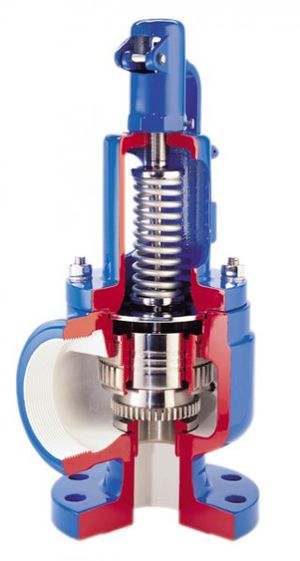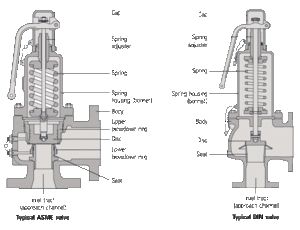Safety Valves
Safety Valve is a valve mechanism which automatically releases a substance from a boiler, pressure vessel, or other system, when the pressure or temperature exceeds preset limits. It is one of a set of pressure safety valves (PSV) or Pressure Relief Valves (PRV), which also includes Relief Valves, Safety Relief Valves, pilot-operated relief valves, Low Pressure Safety Valves, and vacuum pressure safety valves. Safety Valves were first used on steam boilers during the Industrial Revolution. Early boilers operating without them were prone to accidental explosion. Vacuum safety valves are used to prevent a tank from collapsing while it is being emptied, or when cold rinse water is used after hot CIP (clean-in-place) or SIP (sterilization-in-place) procedures. When sizing a vacuum safety valve, the calculation method is not defined in any norm, particularly in the hot CIP or cold water scenario, but some manufacturers have developed sizing simulations.
Function and design
The earliest and simplest safety valve was used on a 1679 steam digester and utilized a weight to retain the steam pressure ; however, these were easily tampered with or accidentally released. On the Stockton and Darlington Railway, the safety valve tended to go off when the engine hit a bump in the track. A valve less sensitive to sudden accelerations used a spring to contain the steam pressure, but these could still be screwed down to increase the pressure beyond design limits. This dangerous practice was sometimes used to marginally increase the performance of a steam engine. In 1856, John Ramsbottom invented a tamper-proof spring safety valve that became universal on railways.
Safety valves also evolved to protect equipment such as pressure vessels (fired or not) and Heat Exchangers. The term safety valve should be limited to compressible fluid applications .The two general types of protection encountered in industry are thermal protection and flow protection.For liquid-packed vessels, thermal relief valves are generally characterized by the relatively small size of the valve necessary to provide protection from excess pressure caused by thermal expansion. In this case a small valve is adequate because most liquids are nearly incompressible, and so a relatively small amount of fluid discharged through the relief valve will produce a substantial reduction in pressure.
Flow protection is characterized by safety valves that are considerably larger than those mounted for thermal protection. They are generally sized for use in situations where significant quantities of gas or high volumes of liquid must be quickly discharged in order to protect the integrity of the vessel or pipeline. This protection can alternatively be achieved by installing a high integrity pressure protection system (HIPPS).
Technical terms
In the petroleum refining, petrochemical, chemical manufacturing, natural gas processing, power generation, food, drinks, cosmetics and pharmaceuticals industries, the term safety valve is associated with the terms pressure relief valve (PRV), pressure safety valve (PSV) and relief valve. The generic term is Pressure relief valve (PRV) or pressure safety valve (PSV) It should be noted that PRVs and PSVs are not the same thing, despite what many people think; the difference is that PSVs have a manual lever to open the valve in case of emergency.
- Relief valve (RV): an automatic system that is actuated by the static pressure in a liquid-filled vessel. It specifically opens proportionally with increasing pressure.
- Safety valve (SV): an automatic system that relieves the static pressure on a gas. It usually opens completely, accompanied by a popping sound.
- Safety relief valve (SRV): an automatic system that relieves by static pressure on both gas and liquid.
- Pilot-operated safety relief valve (POSRV): an automatic system that relieves on remote command from a pilot, to which the static pressure is connected.
- Low pressure safety valve (LPSV): an automatic system that relieves static pressure on a gas. Used when the difference between the vessel pressure and the ambient atmospheric pressureis small.
- Vacuum pressure safety valve (VPSV): an automatic system that relieves static pressure on a gas. Used when the pressure difference between the vessel pressure and the ambient pressure is small, negative and near to atmospheric pressure.
- Low and vacuum pressure safety valve (LVPSV): an automatic system that relieves static pressure on a gas. The pressure is small, negative or positive, and near to atmospheric pressure.
RV, SV and SRV are spring-operated (even spring-loaded). LPSV and VPSV are spring-operated or weight-loaded.
Water heaters
Safety valves are required on water heaters, where they prevent disaster in certain configurations in the event that a the rmostat should fail. There are still occasional, spectacular failures of older water heaters that lack this equipment. Houses can be leveled by the force of the blast.
Pressure cookers
Pressure cookers are cooking pots with a pressure-proof lid. Cooking at pressure allows the temperature to rise above the normal boiling point of water , which speeds up the cooking and makes it more thorough.Pressure cookers usually have two safety valves. On older designs, one is a hole upon which a weight sits. The other is a sealed rubber grommet which is ejected in a controlled explosion if the first valve gets blocked. On newer generation pressure cookers, if the steam vent gets blocked, a spring will eject excess pressure and if that fails, the gasket will expand and release excess pressure downwards between the lid and the pan. The term safety valve is also used metaphorically.

